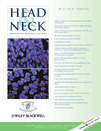Salivary gland carcinomas in children and adolescents: A population-based study, with comparison to adult cases
Abstract
Background.
Salivary gland carcinomas are rare malignancies, particularly in young individuals in whom only scanty data are available from published studies.
Methods.
We searched the SEER database (1973–2006) for patients with a reported diagnosis of salivary gland carcinoma; children/adolescents (<20 years old) were compared with adults.
Results.
We identified 263 children/adolescents (58% girls) and 12,571 adults (43% women). The most common histology was mucoepidermoid carcinoma in both groups, but the percentages of other histologies were different. Children/adolescents had more favorable features with most tumors being localized, with no extension to adjacent tissues or lymphatic spread (76% vs 50% in adults, p < .001). Also most tumors were well differentiated or moderately differentiated (88% vs 49% in adults, p < .001). The 5-year overall survival for children/adolescents was 95% ± 1.5%, compared with 59% ± 0.5% for adults (p < .001).
Conclusion.
When compared with adults, salivary gland carcinomas in children/adolescents are less advanced, and have more favorable features and better outcome. © 2010 Wiley Periodicals, Inc. Head Neck, 2010




